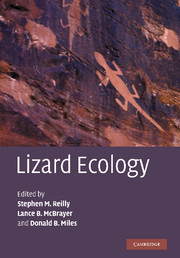Book contents
-
Frontmatter
-
Contents
-
List of contributors
-
Preface
-
Historical introduction: on widely foraging for Kalahari lizards
- I
Organismal patterns of variation with foraging mode
- 1
Movement patterns in lizards: measurement, modality, and behavioral correlates
- 2
Morphology, performance, and foraging mode
- 3
Physiological correlates of lizard foraging mode
- 4
Lizard energetics and the sit-and-wait vs. wide-foraging paradigm
- 5
Feeding ecology in the natural world
- 6
Why is intraspecific niche partitioning more common in snakes than in lizards?
- 7
Herbivory and foraging mode in lizards
- 8
Lizard chemical senses, chemosensory behavior, and foraging mode
- 9
Patterns of head shape variation in lizards: morphological correlates of foraging mode
- 10
Prey capture and prey processing behavior and the evolution of lingual and sensory characteristics: divergences and convergences in lizard feeding biology
- 11
The meaning and consequences of foraging mode in snakes
- II
Environmental influences on foraging mode
-
Index
- References
4 - Lizard energetics and the sit-and-wait vs. wide-foraging paradigm
Published online by Cambridge University Press: 04 August 2010
- Frontmatter
- Contents
- List of contributors
- Preface
- Historical introduction: on widely foraging for Kalahari lizards
- I Organismal patterns of variation with foraging mode
- 1 Movement patterns in lizards: measurement, modality, and behavioral correlates
- 2 Morphology, performance, and foraging mode
- 3 Physiological correlates of lizard foraging mode
- 4 Lizard energetics and the sit-and-wait vs. wide-foraging paradigm
- 5 Feeding ecology in the natural world
- 6 Why is intraspecific niche partitioning more common in snakes than in lizards?
- 7 Herbivory and foraging mode in lizards
- 8 Lizard chemical senses, chemosensory behavior, and foraging mode
- 9 Patterns of head shape variation in lizards: morphological correlates of foraging mode
- 10 Prey capture and prey processing behavior and the evolution of lingual and sensory characteristics: divergences and convergences in lizard feeding biology
- 11 The meaning and consequences of foraging mode in snakes
- II Environmental influences on foraging mode
- Index
- References
Summary
Introduction
The acquisition and allocation of energy can be two of the most critical processes in an organism's life. The amount of energy an individual obtains from the environment can determine not only its survival, but also whether it can engage in reproduction, a very evolutionarily important activity. Among vertebrates, there exists a fairly definitive dichotomy between the high-energy requirements of endotherms and the more energetically “conservative” ectotherms. Within the ectothermic reptiles, the possibility of a similarly clear-cut dichotomy, that between ambushing and actively foraging modes, has been repeatedly discussed, and is the focus of this volume.
Over twenty years ago, Huey and Pianka (1981) asked the question “what are the extra energetic costs of foraging widely?” The observation that wide-foragers travel longer distances through their environment creates the expectation of higher overall daily energy needs (Huey and Pianka, 1981). At the time, Huey and Pianka (1981) estimated that daily maintenance costs could be up to 1.5 times higher in an actively foraging species, a value validated subsequently by Nagy et al. (1984).
The validity and demonstrability of the sit-and-wait (SW) and widely foraging (WF) dichotomy has drawn much scientific attention. A quick perusal of the table of contents of this book can attest to the body of knowledge resulting from such research efforts. While many foraging studies focus on the physiological, morphological or behavioral correlates of foraging mode, here we examine a metric that encompasses all of these aspects at the whole-organism level: field metabolic rate.
- Type
- Chapter
- Information
-
Lizard Ecology , pp. 120 - 140Publisher: Cambridge University PressPrint publication year: 2007
References
- 7
- Cited by



